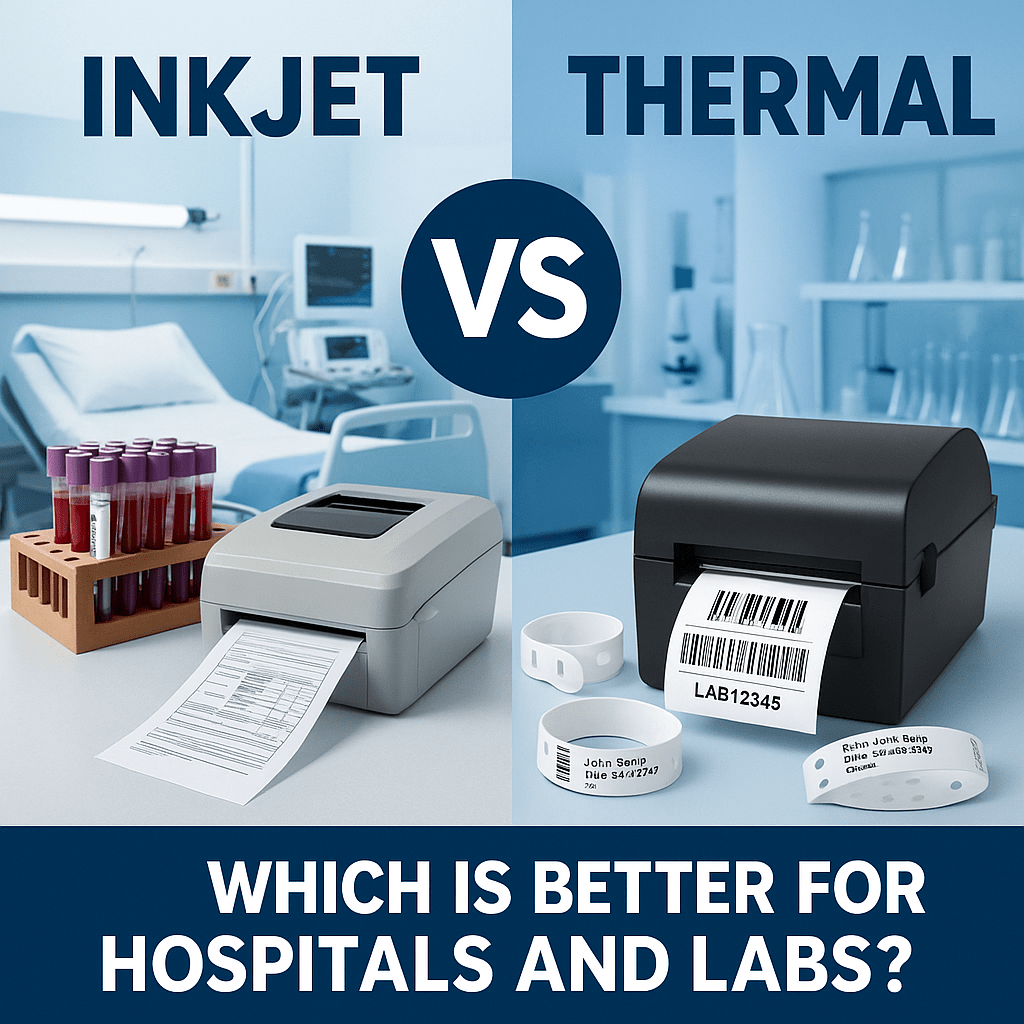Hospitals and laboratories depend on fast, accurate, and durable labeling systems for patient safety and regulatory compliance. That makes printer selection a critical decision. While consumer offices often use inkjet printers, healthcare settings operate under higher demands, specimen accuracy, wristband durability, medication tracking, visitor badges, and long shifts that require reliable equipment.
So which technology performs better in a clinical environment: inkjet or thermal printers?
Let’s break it down.
What Is an Inkjet Printer?
Inkjet printers use liquid ink sprayed onto paper. They’re common for home and office use because they print color photos and documents at low upfront cost.
Pros of Inkjet Printers:
• Cheap entry cost
• Good for color documents
• Widely available
Cons in Healthcare Settings:
• Ink can smear when exposed to moisture, alcohol wipes, or refrigeration
• Cartridges dry out if not used frequently
• Slower printing
• High long-term cost due to ink replacement
• Not optimized for wristbands, specimen tubes, pharmacy labels, or barcodes
For these reasons, hospitals rarely rely on inkjet printers for mission-critical labeling.
What Is a Thermal Printer?
Thermal printers use heat, not ink, to create labels. Healthcare-grade thermal printers come in two types:
1. Direct Thermal (DT)
Uses heat-sensitive paper. No ink or ribbon required. Ideal for:
• Specimen tubes
• Patient wristbands
• Visitor badges
• Pharmacy labels
• Short-term clinical labels
2. Thermal Transfer (TT)
Uses ribbon + synthetic labels for extremely durable printing. Ideal for:
• Freezer labels
• Long-term patient records
• Asset tags
• Harsh chemical or outdoor exposure
Why Hospitals Prefer Thermal Printers:
• No ink smearing
• Resistant to water, alcohol, chemicals, refrigeration
• More accurate barcode scanning
• Faster printing
• Zero ink cartridges = lower costs
• Designed for continuous, 24/7 use
• Supports healthcare label formats (wristbands, vials, charts, pharmacy)
Inkjet vs Thermal: Side-by-Side Comparison
| Feature | Inkjet Printers | Thermal Printers |
|---|---|---|
| Durability | Poor - smears with water/alcohol | Excellent - smudge-proof, heat printed |
| Cost Over Time | High frequent ink replacement | Low - no ink, fewer consumables |
| Speed | Slower | Fast, continuous printing |
| Accuracy for Barcodes | Moderate | High accuracy, medical-grade |
| Label Compatibility | Limited | Wristbands, specimen tubes, pharmacy, charts |
| Reliability | Not designed for 24/7 use | Built for continuous clinical use |
| Regulatory Compliance | Often fails smear tests | Fully compliant for healthcare |
Which Printer Is Better for Hospitals and Labs?
Thermal printers win - by a large margin.
Inkjet printers are suitable for admin offices but not clinical environments. Hospitals require printing that is:
• Smudge-proof
• Chemical-resistant
• Freezer-safe
• Fast for high-volume workflows
• Barcode-accurate
• Compatible with healthcare label media
Only thermal printers meet those criteria.
Real-World Use Cases Where Thermal Wins
1. Specimen Tube Labeling (GTL-100 Test Tube Labeler)
Direct thermal labelers ensure:
• exact alignment
• non-smearing text
• barcode accuracy
• lab freezer resistance
2. Patient Wristbands (GoDEX DT2x)
• Crisp barcodes
• Water/sweat resistance
• High-volume printing for admissions

3. Pharmacy & Medication Labels (GoDEX DT4x)
• Long-lasting thermal print
• Fast label application
• High-precision barcodes
4. Emergency Room Workflows
Nurses and techs need quick, ink-free printing. Thermal printers deliver immediate labels with zero maintenance.
5. Chart Labels & File Folders (GoDEX DT200i)
Perfect for administrative + clinical overlap.
How Much Do Thermal Printers Cost Compared to Inkjet?
Inkjet appears cheaper upfront, but the ongoing costs of:
• ink cartridges
• printheads
• maintenance
quickly exceed the cost of a thermal unit.
Healthcare-grade thermal printers start around $199–$499, and labels cost pennies per print, with no ink required.
What About Color Printing?
If color coding is required, hospitals use:
• Color wristbands (pre-tinted)
• Color synthetic labels
• Color thermal transfer ribbons (resin/wax-resin)
This avoids inkjet’s smearing problem while maintaining durability.
Which Thermal Printer Is Best for Hospitals?
McAuley Labels recommends:
⭐ GTL-100 Test Tube Labeler (labs)
⭐ GoDEX DT2x (wristbands + bedside labeling)
⭐ GoDEX DT4x (pharmacy, charts, reception)
⭐ GoDEX DT200i (hospital printers for admin + clinical)
⭐ MX30i Specimen Labeling Printer (mobile healthcare)
All GoDEX printers come with a 3-year warranty, the longest in the industry.
Final Verdict
Thermal printers are the clear winner for hospitals, labs, pharmacies, clinics, and healthcare facilities. They deliver unmatched durability, speed, regulatory compliance, and cost efficiency.
Inkjet printers simply cannot withstand the demands of clinical environments.

